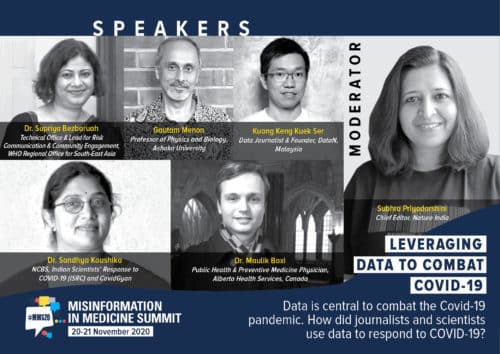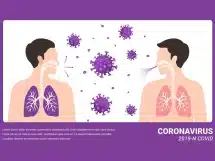Reporting of COVID-19 data has been under the scanner since the pandemic began. Experts address the ongoing need to make sound decisions with the limited data during the coronavirus pandemic at the Misinformation in Medicine Summit 2020.
By Deepika Khurana
The coronavirus crisis has put a spotlight on the need for data availability, correctness, and transparency. In a crisis situation, like we are in today, data can be an essential tool – right from crafting responses and allocating resources to measuring the effectiveness of interventions, such as social distancing, and use of the mask, etc.
However, incomplete or incorrect data can create a false sense of panic or safety, not to mention other harms such as needlessly exposing the private information of COVID-19 patients.
At the third edition of Misinformation in Medicine Summit 2020, six extremely knowledgeable panelists came together for a discussion on ‘leveraging data to combat COVID-19.’
The discussion among Dr. Supriya Bezbaruah, Technical Office & Lead for Risk Communication & Community Engagement WHO Regional Office for South-East Asia, Prof Gautam Menon, Professor of Physics and Biology, Ashoka University, Kuang Keng Kuek Ser, Data Journalist & Founder, DataN, Malaysia, Dr. Sandhya Koushika, Associate Professor, Department of Biological Sciences, TIFR and Advisor on Indian Scientists’ Response to COVID-19 (ISRC) and CovidGyan and Dr. Maulik Baxi, Public Health and Preventive Medicine Physician, Alberta Health Services, Canada was moderated by Shubra Priyadarshini, Chief Editor, Nature India.
The session emphasised broader concerns related to the authenticity of data available during COVID-19.
“After vaccines and virulence of the virus itself, if anything has been under the spotlight or has impacted people’s lives directly during the pandemic, it is data, in its many forms – numbers, figures, models, projections, curves or estimates. In fact, data has evoked both good hope as well as despair, in equal measures since the pandemic outbreak,” said Shubra.
The session evaluated how reporting of COVID-19 data and predictive models in some countries, including India, drew a lot of flak and criticism by medical professionals and the scientific community in particular.
“Deaths in different countries have been reported somewhat differently. In some cases, people are not tested, but they have COVID symptoms and are not recorded anywhere. Also, there have been cases where people got discharged from hospitals, but then they died a few days later of some COVID related complication. So there have been some real problems in reporting deaths,” said Koushika.
According to her, smaller nations that have done well in containing the virus have been relatively transparent and communicated information well. “I think the underlying issue is that the governments both in India and globally are very conflicted on reporting. They want to present a picture of where their nation or their strategy is successful. And that I believe has been a primary driver which is leading nations to tune their responses on how data should be reported,” added Koushika.
Prof. Gautam couldn’t agree with her more, as he mentioned, “What I think has really come out of COVID-19 reporting of data in India specifically, has been the use of this crowdsourced initiative, where the public just looked at newspapers and reports of states, etc., and combined and published those on websites. This data has been universally used, and it tends to be a little more trusted than the standard data available on the government websites,” he said.
Gautam further stated that the government websites in India generally report datasets in pdf format which is quite unusual because such reports are optimized to be read by newsrooms and public-relations people but not to the scientists who are actually trying to understand the situation through these numbers.
“It’s a complex picture where there are positives and negatives at the same time,” he quipped.
The session also brought to the forefront the challenges faced by newsrooms when it comes to reporting of data because COVID-19, much like SARS and MERS, is a data-centric story.
Keng, an award-winning journalist noted that only big newsrooms can afford to invest heavily in dedicated data teams and data-driven reporting. “If you’ll notice, engaging, explainer journalism is coming out of newsrooms that are better equipped. The rest of them are struggling with the interpretation of the numbers because before reporting they themselves have to understand those numbers and datasets. So that’s a big challenge as many newsrooms don’t have people dedicated to data reporting,” he said.
According to Keng, earlier experience of SARS and MERS makes no difference when it comes to COVID-19 reporting. “It goes back to the capacity of newsrooms. But with the pandemic, many editors and newsrooms have now realised the importance of doing good journalism, which I believe was long due,” he added.
So does that mean we need to fact check medical misinformation in real-time? While speaking about the consequences of data reporting on the public, Maulik Baxi said, “As a matter of fact, data doesn’t exist by itself as an island. Data exists within the context, within the infrastructure. Data are political; they have their own social, cultural, and organizational values.”
Further, about the misinterpretation of data, he quipped, “When COVID-19 started, everyone had their own interpretation of who is a coronavirus patient, or about COVID-19 recoveries, etc. This gradually kept changing with our better understanding of the virus. Also, we got to realise that this is a very new pathogen. In fact, we are still learning about the evolution of the disease, which I think is the root cause of misinformation.”
Agreed Supriya who reinforced that data may sometimes have its own limitation. “It depends on when, where, and how you collect data. The environment around it is equally important. So as you start analysing data, you need to have a clear understanding of its context and how it is gathered,” she said.
Many countries have been demanding disseminated data. But does the public really need to have access to disaggregated data? “Absolutely not, because that kind of data is useful only to the modellers. It is not helpful in a daily life situation. Besides, whenever you make data more granular there are more problems related to privacy. So governments should be mindful of releasing data of this form,” cautioned Gautam.
One of the cornerstones of the discussion was that because COVID-19 is a new and evolving pathogen, the uncertainties should be conveyed in a way that it does not create confusion or make people complacent. The emphasis, therefore, should be to have a fine balance between data availability, data privacy, and data transparency.
You can watch the recording of the session here.

















